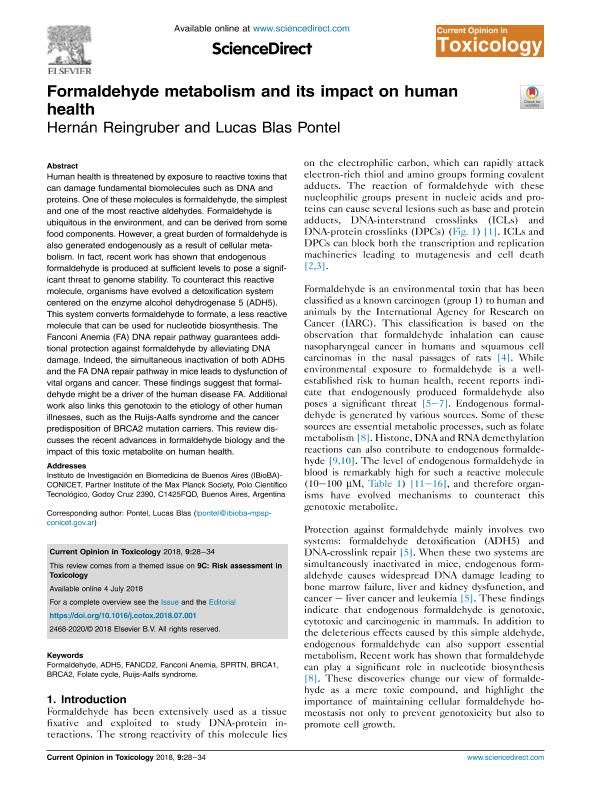Mostrar el registro sencillo del ítem
dc.contributor.author
Reingruber, Hernán

dc.contributor.author
Pontel, Lucas Blas

dc.date.available
2019-11-07T19:52:42Z
dc.date.issued
2018-06
dc.identifier.citation
Reingruber, Hernán; Pontel, Lucas Blas; Formaldehyde metabolism and its impact on human health
; Elsevier; Current Opinion in Toxicology; 9; 6-2018; 28-34
dc.identifier.issn
2468-2020
dc.identifier.uri
http://hdl.handle.net/11336/88240
dc.description.abstract
Human health is threatened by exposure to reactive toxins that can damage fundamental biomolecules such as DNA and proteins. One of these molecules is formaldehyde, the simplest and one of the most reactive aldehydes. Formaldehyde is ubiquitous in the environment, and can be derived from some food components. However, a great burden of formaldehyde is also generated endogenously as a result of cellular meta- bolism. In fact, recent work has shown that endogenous formaldehyde is produced at sufficient levels to pose a signif- icant threat to genome stability. To counteract this reactive molecule, organisms have evolved a detoxification system centered on the enzyme alcohol dehydrogenase 5 (ADH5). This system converts formaldehyde to formate, a less reactive molecule that can be used for nucleotide biosynthesis. The Fanconi Anemia (FA) DNA repair pathway guarantees addi- tional protection against formaldehyde by alleviating DNA damage. Indeed, the simultaneous inactivation of both ADH5 and the FA DNA repair pathway in mice leads to dysfunction of vital organs and cancer. These findings suggest that formal- dehyde might be a driver of the human disease FA. Additional work also links this genotoxin to the etiology of other human illnesses, such as the Ruijs-Aalfs syndrome and the cancer predisposition of BRCA2 mutation carriers. This review dis- cusses the recent advances in formaldehyde biology and the impact of this toxic metabolite on human health.
dc.format
application/pdf
dc.language.iso
eng
dc.publisher
Elsevier

dc.rights
info:eu-repo/semantics/openAccess
dc.rights.uri
https://creativecommons.org/licenses/by-nc-nd/2.5/ar/
dc.subject
FORMALDEHYDE
dc.subject
FANCONI ANEMIA
dc.subject
CANCER
dc.subject
ADH5
dc.subject.classification
Biología Celular, Microbiología

dc.subject.classification
Ciencias Biológicas

dc.subject.classification
CIENCIAS NATURALES Y EXACTAS

dc.title
Formaldehyde metabolism and its impact on human health
dc.type
info:eu-repo/semantics/article
dc.type
info:ar-repo/semantics/artículo
dc.type
info:eu-repo/semantics/publishedVersion
dc.date.updated
2019-10-22T17:52:24Z
dc.journal.volume
9
dc.journal.pagination
28-34
dc.journal.pais
Países Bajos

dc.journal.ciudad
Amsterdam
dc.description.fil
Fil: Reingruber, Hernán. Consejo Nacional de Investigaciones Científicas y Técnicas. Oficina de Coordinación Administrativa Parque Centenario. Instituto de Investigación en Biomedicina de Buenos Aires - Instituto Partner de la Sociedad Max Planck; Argentina
dc.description.fil
Fil: Pontel, Lucas Blas. Consejo Nacional de Investigaciones Científicas y Técnicas. Oficina de Coordinación Administrativa Parque Centenario. Instituto de Investigación en Biomedicina de Buenos Aires - Instituto Partner de la Sociedad Max Planck; Argentina
dc.journal.title
Current Opinion in Toxicology
dc.relation.alternativeid
info:eu-repo/semantics/altIdentifier/url/https://www.sciencedirect.com/science/article/pii/S2468202017301456
dc.relation.alternativeid
info:eu-repo/semantics/altIdentifier/doi/http://dx.doi.org/10.1016/j.cotox.2018.07.001
Archivos asociados
